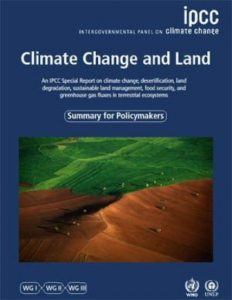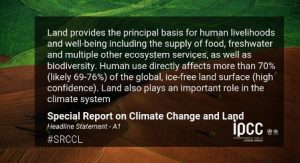Land and Climate Change: Critical Correlation and Impacts
Land is a critical resource: The world body IPCC recently released a report on climate change and land—critical evidence and input that goes into forthcoming climate and environment negotiations.

Land has a significant correlation with climate change. This is because land acts both as a source as well as a sink for greenhouse gases (GHGs) but this aspect is seldom discussed. Geneva-based UN body, the Intergovernmental Panel on Climate Change (IPCC) released a Special Report on Climate Change and Land (SRCCL) in its 50th session held on 2–7 August 2019. It highlighted how land-use patterns affect climate change and in turn gets affected by land. The Summary for Policymakers (SPM) was also presented in the press conference for a meaningful engagement with governments to address the growing concerns of land and climate change.
Land is a critical resource, IPCC report says that land is already under growing human pressure and climate change is acting to these pressures. At the same time, keeping global warming to well below 2ºC can be achieved only by reducing greenhouse gas emissions from all sectors including land and food.
Figures associated with climate change paints an alarming picture. The concentration of carbon dioxide in our atmosphere (as in 2018) is 408 parts per million (ppm), which is highest in the last 3 million years. Almost 800 million people or 11per cent of the world’s population is vulnerable to the various impacts of climate change such as droughts, floods, heat-waves, extreme weather events and rise in the sea level. The global average temperature has increased up by 0.9ᵒC, compared to its level in the 19th century, whereas ocean temperature has risen up by 0.4ᵒC from 1969 onwards. Greenland and Antarctica that store most of the world’s ice have lost 286 and 127 billion tonnes of ice, respectively. Sea level has risen up by 8 inches, leading to submergence of a million ha of coastal areas, each year.
Land Emits High Levels of GHGs
According to the report, land acts both as a source and as a sink for greenhouse gases (GHGs) because it is used for various purposes such as urbanization, industries, agriculture, pastoralism, which in the process leads to the GHGs emission. As per this report, 22 per cent of the total GHG emissions come from agriculture, forestry and other land use.
The report extensively talks about the environmental impact of the process of food production. Report highlights that large amount of GHGs is added to the atmosphere through this process. It stresses the need to prevent both over-consumption and wastage of food. 1/3rdof the food produced is wasted; when decomposed, it releases large amounts of GHGs in air.
Also Read : Change Is In The Air
Land also acts as a sink for emissions because land through its vegetation removes carbon dioxide through their natural process of photosynthesis. Due to deforestation, earth has lost 3 per cent of its forest cover since 1990. Despite deforestation and widespread exploitation, the land has removed more emissions than it has emitted. The report points out that land has removed 6 giga tonnes of emissions every year, from 2007–2016. This figure is equivalent to the total emissions by the United States of America, which is the largest polluter followed by China. In simpler terms, land through its vegetation sequesters a third of carbon emissions.
Just like land use pattern adds to climate change, climate change has an extremely negative effect on land as well. The report highlights the effect of climate change on land degradation and desertification. Intense heating hampers vegetation growth, and so with reduced vegetation, degree of soil erosion increases. Increased temperature also leads to a reduction in soil moisture leading to increased aridity. The degraded land is also a contributor to climate change as the degraded land loses soil carbon and emits GHGs.
The report defines desertification as land degradation in arid, semi-arid and sub-humid areas that are collectively known as drylands. According to the report, climate change will accelerate desertification process. Reduced vegetation will expose soil for erosion and reduction in soil moisture. With no vegetation to hold the soil, there would be a recurrence of dust storms and sandstorms, leading to decreased precipitation, exacerbating the process of desertification. According to the report, majority of the 1.3 to 3.2 billion people affected by land desertification are living in poverty in developing countries.
Climate change has the potential to hamper food security in the future, the report says. The report further emphasis that climate change and its associated risks will reduce crop yields, driving up prices, leaving more people hungry and poor.

Increased food prices and the recurrent natural calamities and extreme weather conditions will push more people into poverty.
Mitigation Strategies
Mitigation strategies suggested in the report largely focuses on the need for sustainable use of land. The report proposes reduced deforestation and an increase in afforestation and reforestation, which will have a huge potential in reducing emission levels in the atmosphere.
The report further stresses the need to change the methods adopted in food production. With 1/3rd of the food being wasted, there is a need to curb this as in the process of decomposition of the food that is wasted, GHGs are emitted. Issue of over-consumption and the need for its prevention is also highlighted. A change in dietary choices with a need to shift towards plant-based foods is stressed upon.
The international body has highlighted the role of indigenous communities in the conservation of land and forest resources.
While highlighting the mitigation strategies, the report also underlined the risk associated with these methods. While afforestation is a necessary step in combating climate change and various other risks associated with it, proper assessment should be made about the landscape. For example, cultivating forests on grassland will reduce the capacity of the land to act as a carbon sink. Similarly, planting foreign species have the potential of reducing the population of native plant species. Also, there is a saturation point for land after which it would no longer be able to absorb carbon. In this case, artificial techniques such as carbon sequestration and Direct Air Capture and Storage (DACS) would need to be employed.
Also Read : The Crisis Of Marine Pollution Oceans Turning Into Plastic Soup
One flip side of afforestation and reforestation as underlined in the report is that most of it would be carried out on land currently under agriculture. Reduced land under cultivation would lead to less food production, driving up its prices, thus hampering food security.
In the 14th Conference of Parties (COP14) to the United Nations Convention to Combat Land Desertification, being organized in India, the IPCC Special Report has been widely discussed. The member countries of the UNCCD had in its COP12 in 2015 adopted the target to achieve land degradation neutrality target by 2030 to mitigate climate change.
